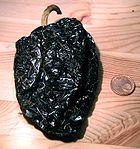
Poblano
Encyclopedia



Chili pepper
Chili pepper is the fruit of plants from the genus Capsicum, members of the nightshade family, Solanaceae. The term in British English and in Australia, New Zealand, India, Malaysia and other Asian countries is just chilli without pepper.Chili peppers originated in the Americas...
originating in the State of Puebla
Puebla
Puebla officially Estado Libre y Soberano de Puebla is one of the 31 states which, with the Federal District, comprise the 32 Federal Entities of Mexico. It is divided in 217 municipalities and its capital city is Puebla....
, Mexico
Mexico
The United Mexican States , commonly known as Mexico , is a federal constitutional republic in North America. It is bordered on the north by the United States; on the south and west by the Pacific Ocean; on the southeast by Guatemala, Belize, and the Caribbean Sea; and on the east by the Gulf of...
. Dried, it is called a chile ancho ("wide chile"). The ripened red poblano is significantly hotter and more flavorful than the less ripe, green poblano. While poblanos tend to have a mild flavor, occasionally and unpredictably, they can have significant heat. Different peppers from the same plant have been reported to vary substantially in heat intensity. A closely related variety is the mulato, which is darker in color, sweeter in flavor and softer in texture.
One of the most popular peppers grown in Mexico
Mexico
The United Mexican States , commonly known as Mexico , is a federal constitutional republic in North America. It is bordered on the north by the United States; on the south and west by the Pacific Ocean; on the southeast by Guatemala, Belize, and the Caribbean Sea; and on the east by the Gulf of...
, the bush (of the species Capsicum annuum
Capsicum annuum
Capsicum annuum is a domesticated species of the plant genus Capsicum native to southern North America and northern South America. The three species C. annuum, C. frutescens and C. chinense all evolved from a single common ancestor located somewhere in the northwest Brazil - Colombia area...
) is multi-stemmed and can reach 25 inches in height. The pod is about three to six inches long and about two to three inches wide. An immature poblano is dark purplish green in color, but the mature fruits eventually turn a red so dark as to be nearly black.
Poblanos are grow in zones 10-12
Hardiness zone
A hardiness zone is a geographically defined area in which a specific category of plant life is capable of growing, as defined by climatic conditions, including its ability to withstand the minimum temperatures of the zone...
and do best with a soil ph between 7.0 - 8.5. Poblanos typically prefer full sunlight and during harvest in late summer may require additional support for the growing fruits. A poblano takes around 200 days from seed to harvest and require temperatures to be at least 64 degrees F to germinate.
Preparation methods include: dried, coated in whipped egg (capeado) and fried, stuffed, or in mole
Mole (sauce)
Mole is the generic name for a number of sauces used in Mexican cuisine, as well as for dishes based on these sauces...
sauces. It is particularly popular during the Mexican
Mexico
The United Mexican States , commonly known as Mexico , is a federal constitutional republic in North America. It is bordered on the north by the United States; on the south and west by the Pacific Ocean; on the southeast by Guatemala, Belize, and the Caribbean Sea; and on the east by the Gulf of...
independence festivities as part of a dish called chiles en nogada
Chiles en nogada
Chiles en nogada is a dish from Mexican cuisine. The name comes from the Spanish word for the walnut tree, nogal. It consists of poblano chiles filled with picadillo topped with a walnut-based cream sauce, called nogada, and pomegranate seeds, giving it the three colors of the Mexican flag: green...
, which incorporates green, white and red ingredients corresponding to the colors of the Mexican flag. This may be considered one of Mexico
Mexico
The United Mexican States , commonly known as Mexico , is a federal constitutional republic in North America. It is bordered on the north by the United States; on the south and west by the Pacific Ocean; on the southeast by Guatemala, Belize, and the Caribbean Sea; and on the east by the Gulf of...
's most symbolic dishes by its nationals. It is also usually used in the widely found dish chile relleno
Chile relleno
The chile relleno, literally "stuffed chile," is a dish of Mexican cuisine that originated in the city of Puebla. It consists of a roasted fresh poblano pepper , sometimes substituted with non-traditional Hatch green chile, Anaheim, pasilla or even jalapeño chili pepper...
. Poblanos are popular in the United States and can be found in grocery stores in the states bordering Mexico and in urban areas.
After being roasted and peeled (which improves the texture by removing the waxy skin), poblano peppers can be preserved by either canning or freezing. Storing them in airtight containers will suffice for several months. When dried, the poblano becomes a broad, flat, heart-shaped pod called an ancho chile (meaning "wide" in Spanish
Spanish language
Spanish , also known as Castilian , is a Romance language in the Ibero-Romance group that evolved from several languages and dialects in central-northern Iberia around the 9th century and gradually spread with the expansion of the Kingdom of Castile into central and southern Iberia during the...
); from this form it is often ground into a powder used for flavoring recipes.
"Poblano" is also the word for an inhabitant of Puebla, and mole poblano refers to the spicy chocolate chili sauce originating in Puebla.

